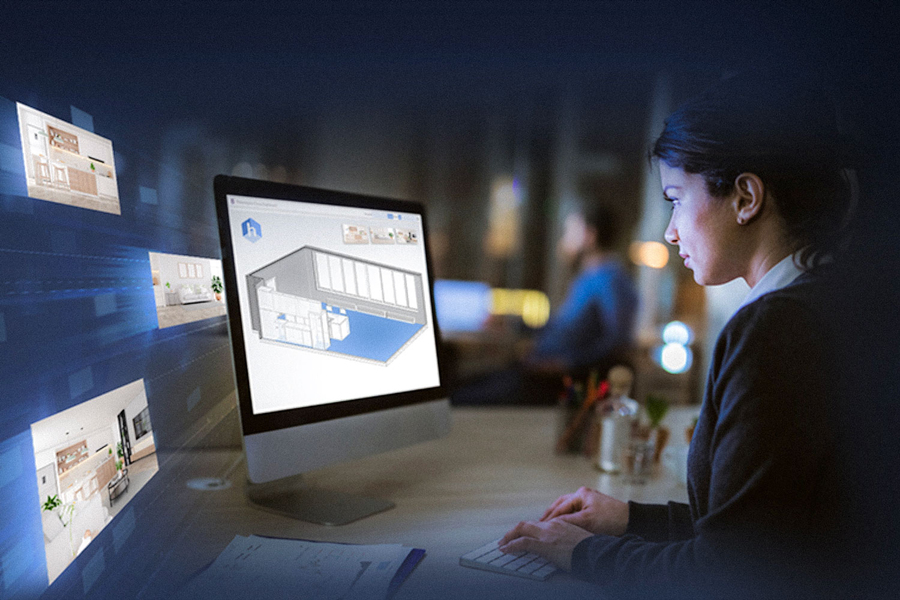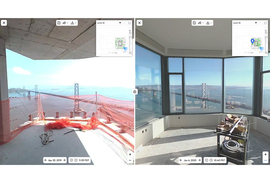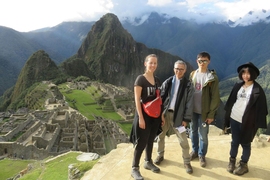Property assessments sit at the center of home appraisals, insurance claims, renovation projects, and a number of other important processes. Inaccurate or delayed assessments can set projects back and stick consumers with higher costs.
Now, a platform first developed at MIT makes creating detailed property assessments as easy as snapping a few pictures. The alumni-founded startup Hosta a.i. analyzes images to produce precise measurements of spaces, detailed floor plans, 3D models of rooms, and bills of materials. It can also evaluate the conditions of materials to assess damage and identify risks, such as the use of flammable materials or inadequate sprinkler to volume ratios.
“Contractor and insurance companies hardly ever come up with the same estimate,” says Hosta a.i. CEO and co-founder Henriette Fleischmann MBA ’19, who founded the company with executive chair and CTO Rachelle Villalon SM ’08, PhD ’17. “Our technology is accelerating these processes and reducing friction for the adjuster, contractor, and the consumer. We’re helping people get their homes repaired more quickly, so they can feel like home again.”
Hosta a.i. is currently working with insurers, contractors, and mortgage lenders to give everyone fast and accurate information about their built surroundings. The founders say they’re still considering the possibilities unlocked by giving people a complete view of properties without forcing them to go on-site.
“I think there’s an opportunity to help speed the transition to more energy efficient buildings,” Fleischmann says. “We can create an understanding of how heat moves through a room. There are plenty of applications across industries that require built-environment understanding.”
A technology comes together
Villalon worked as an architect, software engineer, and consultant before founding Hosta. As a third-generation architect, she had early exposure to the challenges on construction job sites, from documentation to project coordination, as well as the evolution of computer-aided design (CAD) systems.
At MIT, her research focused on applying artificial intelligence to problems in the built environment, including ways to teach machines about architecture and ways to turn images into 3D maps and objects. She spent her time as a master’s and PhD student in the Design and Computation Group within the School of Architecture and Planning as well as at the Media Lab and the Computer Science and Artificial Intelligence Laboratory (CSAIL).
“There were so many problems in architecture and construction, and I just remember thinking I needed to further my technical and theoretical foundations to challenge the limits of current industry practice,” Villalon says. “MIT became this utopia of information and knowledge for me. It helped me construct a critical view of the industry and apply new creative technologies to it.”
Originally from Germany, Fleischmann worked at large companies in the automotive and fashion industries before coming to the MIT Sloan School of Management, where she received her MBA while focusing on AI and entrepreneurship.
“It was an amazing program,” Fleischmann says. “It helped me regain energy and think about what was next. I loved how hands-on MIT was. I spent a lot of time at the [Martin Trust Center for MIT Entrepreneurship] and gravitated toward tech-heavy startups.”
By the time Fleischmann met Villalon, the PhD graduate was looking for a co-founder who could help drive the commercialization of Hosta a.i.’s technology. With a prototype at hand, a patent filed, and market testing underway with Hosta a.i.’s advisor Jose Pacheco MBA ’12, Villalon and Fleischmann made big strides at MIT.
“I remember sitting in an MIT classroom, and I had taken a picture in Building 9 without an app or special sensors, uploaded it with our first API, and out came this list of results and floorplans that showed all the items, their measurements, and how big the spaces were,” Villalon says. “When I first saw that output, I just thought about how much time I’d spent as an architect trying to manually recreate spaces, and now all I had to do was snap a picture.”
The founders received funding from MIT Sandbox and entered into several MIT startup accelerator programs, including the School of Architecture and Planning’s MITdesignX, the MIT Industrial Liaison Program’s STEX25, and the Trust Center’s delta v accelerator. Hosta a.i. has continued working with MIT through the CSAIL Alliances program and the Industrial Liaison Program.
Today, anybody in a home or on a job site can click a link and follow Hosta a.i.’s prompts to take photos using their phone. Once the photos are uploaded, Hosta a.i. uses artificial intelligence to automatically create floor plans and CAD models. Beyond measurements, the software can classify all the objects and materials in the room to create a detailed bill of materials — key information to determine how much a project will cost.
“With our solution, you can just snap a picture of a space. There’s no app, you don’t need any architectural knowledge, there’s no LIDAR or anything heavy involved, and you can extract all of this information,” Villalon says. “We’re also building expert reasoning into the technology. It’s really game-changing in the industry.”
Scaling for impact
The founders say their solution cuts 80 percent of the time out of property assessments while avoiding the errors associated with manual assessments.
“The insurance adjustor gets a package that lets them create a claim estimate in minutes,” Fleischmann says. “We realized the big insurance companies are making estimates thousands of times every day. That amounts to a lot of time and dollars saved.”
Hosta a.i. struggled to scale at first, but in-person challenges caused by the Covid-19 pandemic helped accelerate the business. The founders now say they are firmly in growth mode.
“At MIT we created momentum, but building a deep tech company is challenging,” Fleischmann says. “My advice for founders is to try to create a minimum viable product quickly to act as a market feeler and then build on top of that.”
As Hosta a.i. continues to scale, the founders believe the technology holds promise to help companies cut a significant source of their greenhouse gas emissions.
“Our vision is to reduce carbon emissions by leading the world’s transition to virtual property assessments,” Fleischmann says. “We’re making sure there’s a shift in the industry as a whole, not just in insurance but in the entire built environment.”









